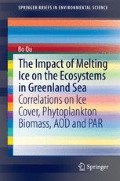Abstract
This chapter investigated the relationships between aerosol optical depth, sea-ice cover (ICE), and cloud cover (CLD) in the Greenland Sea in 20°W–10°E, 65°N–85°N during the period 2003–2012. We focused more on 70°N–80°N and divided it into two 5° zonal apart. Remote sense satellite data were used to do correlation analysis. Enhanced statistics methods are used for correlation and regression analysis. According to the 10-year data, AOD was high in spring, and low in summer, and it rose back again in autumn. AOD content was generally higher in southern region (70°N–75°N) than the northern region (75°N–80°N). AOD and ICE had positive correlations, while AOD and CLD had negative correlations. The peaks of ICE and CLD were all 1 month earlier than the peak of AOD. That indicates both ice cover and cloud cover all had influenced on AOD content. After shifting ICE and CLD 1 month later, they both had long-term equilibrium relationship with AOD. The correlation between AOD and ICE was stronger than the correlation between AOD and CLD, indicating that the aerosols in Arctic mostly came from the sea ice rather than from the air cloud. Melting ice (MI) resulted in the increasing of the AOD content.
Access this chapter
Tax calculation will be finalised at checkout
Purchases are for personal use only
References
Feingold, G., Eberhard, W. L., Veron, D. E., & Previdi, M. (2003). First measurements of the Twomey indirect effect using ground-based remote sensors. Geophysical Research Letters, 30, 1287.
Gabric, A. J., Qu, B., Matrai, P. A., & Hirst, A. C. (2005). The simulated response of dimethylsulphide production in the arctic ocean to global warming. Tellus, 57B, 391–403.
Kaufman, Y. J., Koren, I., Remer, L. A., Rosenfeld, D., & Rudich, I. (2005). The effect of smoke, dust, and pollution aerosol on shallow cloud development over the Atlantic Ocean. Proceedings of National Academy of Science, 102, 11207–11212.
Monahan, E. C., & Muircheartaigh, I. (1980). Optimal power-law description of oceanic whitecap coverage dependence on wind speed. Journal of Physical Oceanography, 10, 2094–2099.
Nilsson, E. D., Martensson, E. M., Ekeren, J Sv, Leeuw, Gd, Moerman, M. M., & O’Dowd, C. (2007). Primary marine aerosol emissions: Size resolved Eddy covariance measurements with estimates of the sea salt and organic carbon fractions. Atmospheric Chemistry and Physics Discussions, 7, 13345–13400.
Pang, H. (2007). Econometrics (pp. 265–284). Beijing: Science Publishing Press.
Quinn, P. K., Shaw, G., Andrews, E., Dutton, E. G., Ruoho-Airola, T., & Gong, S. L. (2007). Arctic haze: Current trends and knowledge gaps. Tellus B, 59, 99–114.
Quinn, P. K., Bates, T. S., Baum, E., Doubleday, N., Fiore, A. M., Flanner, M., et al. (2008). Short-lived pollutants in the Arctic: Their climate impact and possible mitigation strategies. Atmospheric Chemistry and Physics, 8, 1723–1735. doi:10.5194/acp-8-1723-2008.
Ramanathan, V., Ramana, M. V., Roberts, G., Kim, D., Corrigan, C., Chung, C., et al. (2007). Warming trends in Asia amplified by brown cloud solar absorption. Nature, 448, 575–578.
Serreze, M. C., Holland, M. M., & Stroeve, J. (2007). Perspectives on the Arctic’s shrinking sea-ice cover. Science, 315(5818), 1533–1536. doi:10.1126/science.1139426.
Serreze, M., Walsh, J., Chapin, F., Osterkamp, T., Dyurgerov, M., Romanovsky, V., et al. (2000). Observational evidence of recent changes in the northern high latitude environment. Climate Change, 46, 159–207.
Slingo, A. (1990). Sensitivity of the Earth’s radiation budget to changes in low clouds. Nature, 343, 49–51.
Struthers, H., Ekman, A. M. L., Glantz, P., Iversen, T., Kirkevåg, A., Mårtensson, E. M., et al. (2011). The effect of sea-ice loss on sea salt aerosol concentrations and the radiative balance in the Arctic. Atmospheric Chemistry and Physics, 11, 3459–3477.
Author information
Authors and Affiliations
Corresponding author
Rights and permissions
Copyright information
© 2015 The Author(s)
About this chapter
Cite this chapter
Qu, B. (2015). Aerosol Optical Depth, Ice Cover, and Cloud Cover. In: The Impact of Melting Ice on the Ecosystems in Greenland Sea. SpringerBriefs in Environmental Science. Springer, Berlin, Heidelberg. https://doi.org/10.1007/978-3-642-54498-9_3
Download citation
DOI: https://doi.org/10.1007/978-3-642-54498-9_3
Published:
Publisher Name: Springer, Berlin, Heidelberg
Print ISBN: 978-3-642-54497-2
Online ISBN: 978-3-642-54498-9
eBook Packages: Earth and Environmental ScienceEarth and Environmental Science (R0)

